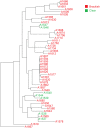Brackish habitat dictates cultivable Actinobacterial diversity from marine sponges
- PMID: 28692665
- PMCID: PMC5503172
- DOI: 10.1371/journal.pone.0176968
Brackish habitat dictates cultivable Actinobacterial diversity from marine sponges
Abstract
Bacterial communities associated with marine invertebrates such as sponges and ascidians have demonstrated potential as sources of bio-medically relevant small molecules. Metagenomic analysis has shown that many of these invertebrates harbor populations of Actinobacteria, many of which are cultivable. While some populations within invertebrates are transmitted vertically, others are obtained from the environment. We hypothesized that cultivable diversity from sponges living in brackish mangrove habitats have associations with Actinobacterial populations that differ from those found in clear tropical waters. In this study, we analyzed the cultivable Actinobacterial populations from sponges found in these two distinct habitats with the aim of understanding the secondary metabolite potential. Importantly, we wanted to broadly evaluate the potential differences among these groups to guide future Actinobacterial collection strategies for the purposes of drug discovery.
Conflict of interest statement
Figures











References
-
- Hentschel U, Fieseler L, Wehrl M, Gernert C, Steinert M, Hacker J, et al. Microbial diversity of marine sponges. Prog Mol Subcell Biol. 2003;37:59–88. Epub 2005/04/14. . - PubMed
-
- Taylor MW, Radax R, Steger D, Wagner M. Sponge-associated microorganisms: evolution, ecology, and biotechnological potential. Microbiol Mol Biol Rev. 2007;71(2):295–347. Epub 2007/06/08. doi: 10.1128/MMBR.00040-06 . - DOI - PMC - PubMed
-
- Fuerst JA. Diversity and biotechnological potential of microorganisms associated with marine sponges. Appl Microbiol Biotechnol. 2014;98(17):7331–47. doi: 10.1007/s00253-014-5861-x . - DOI - PubMed
-
- Hirata Y, Uemura D. Halichondrins-Antitumor polyether macrolides from a marine sponge. Pure and Applied Chemistry. 1986;58:701–10.
-
- Newman S. Eribulin, a simplified ketone analog of the tubulin inhibitor halichondrin B, for the potential treatment of cancer. Curr Opin Investig Drugs. 2007;8(12):1057–66. . - PubMed
MeSH terms
Grants and funding
LinkOut - more resources
Full Text Sources
Other Literature Sources

